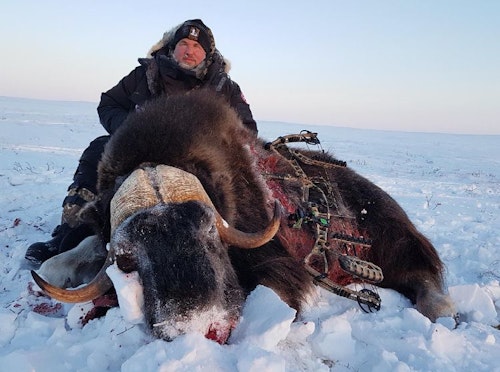When the little commuter jet landed in Coppermine, a small village on the Coronation Gulf of the Beaufort Sea in the extreme north of Canada’s Northwest Territories, the first thing I saw, besides an endless sea of white, was a billboard-sized thermometer. It read minus-33 degrees Celsius — about negative-27 degrees Fahrenheit. It was late March, and I was here to bowhunt Oomingmak – the fascinating prehistoric muskox.
Ovibos moschatus, as they are known scientifically, weigh between 400 to 800 pounds, and are survivors of the last Ice Age. Oomingmak loosely translates to “the animal with skin like a beard” for their distinct fur that hangs down nearly to the ground. While they graze on a variety of plants in spring and summer, during winter, which lasts an average of 4.5 months, they use their excellent noses to locate food under the snowpack, digging it out with their front hooves or by dropping their heads to break the crusty snow. Of course, in this isolated region, they rarely see people, and thus are not afraid when approached. Or so I was told. As we shall see, I learned the hard way my first day afield this isn’t always so.
Spring hunts are conducted with native guides who drive a snow machine pulling an open sled with high sides in which the hunter rides. You lay flat, and after five hours of bumping and banging and not being able to see on the ride to camp, I was more than ready to stretch my legs. Of course, part of the reason you remain down low and protected is to keep you from being frostbitten, which would happen in seconds to any exposed skin.
Our camp was a trio of large wall tents. To keep us warm at night in temperatures that reached minus-40 degrees with a stiff wind, the outfitter provided huge Arctic sleeping bags laid on thick caribou skins. A small gas stove was all the external heat we had. As you can imagine, you tried desperately not to have to get up and go in the middle of the night.
Muskox live in the open, unsheltered tundra, enduring unforgiving blizzards, darkness and freezing temperatures. One secret to muskox survival is their fur, which consists of two layers — a long outer layer that looks more like hair than fur, and a short fuzzy underlayer of qiviut. Qiviut is one of the warmest furs on earth, stronger and more durable than sheep’s wool, and softer than cashmere. During spring, muskox shed their qiviut as the season warms up. The qiviut often gets stuck on willow branches or grasses and is collected by crafters to make sweaters, scarfs and mittens.
Extremely social animals, muskox live in herds both large and small. They use their numbers as their primary defense against wolves and polar bears. When danger approaches, muskox stick together. If there is only a single predator, muskox form a line of defense in the direction of that predator. If there are multiple predators, muskox form a circle with their heads and horns all facing outward, making the circle impenetrable. Calves will stay near their mother or be at the center of the circle.
What nobody told me was that, at times, bulls would often charge the threat — in this case, me. In this extreme cold, I was bundled up so much I looked like Pillsbury Dough Boy, wearing large, Arctic boots with 4-inch soles. I waddled as much as I walked when I made my first stalk, trying to get in range of seven bulls.
I figured, what the heck, they’re dumb musk ox, right? I’ll just stroll up to about 30 yards and arrow the biggest one. But at 50 yards, they formed their skirmish line, and as one, here they came. Holy macaroni! I turned tail and waddled as fast as I could, beating them by a breath to the edge of a 30-yard drop-off, over which I jumped, sliding to the bottom on my butt and doing my best to protect my bow.
The next time, I was a bit more discreet. Two bulls were together, and I was able to get to 35 yards. My arrow flew true, and soon I had a superb bull, which at the time would have cracked the Pope & Young record book’s top 10 had I entered it. Interestingly, this bull’s buddy would not leave, and we had to radio another hunter to come shoot it so we could recover our animals.
Today you can bowhunt muskox in Alaska, northern Canada and Greenland. The spring season runs from early March until the end of April, and the fall season runs mid-August to the end of September. Fall hunts feature mild temperatures, comfortable living and travel on ATVs — but my thinking was, if I am going to hunt the Arctic, I want to experience the Arctic. And it was something — northern lights dancing, extreme temperatures, fabulous native guides, a frostbitten tip of the nose — and the discovery that muskox meat is some of the tastiest wild meat I’ve ever had.

Today Kugluktuk is part of Nunavut, which broke from NWT in 1999 as a separate province. In addition to Nunavut, you can hunt muskox in Greenland and Alaska, though nonresident tags in Alaska are tough to obtain and quite spendy.
You need to be outfitted for these hunts. An excellent place to start the research is with a high-quality booking agent such as Worldwide Trophy Adventures, www.worldwidetrophyadventures.com. While it may sound crazy, it’s something I’d love to experience again.
Have you ever bowhunted the Arctic or the extreme below-zero cold? Drop me a note at editor@grandviewoutdoors.com and share your stories; I’d love to hear them!






